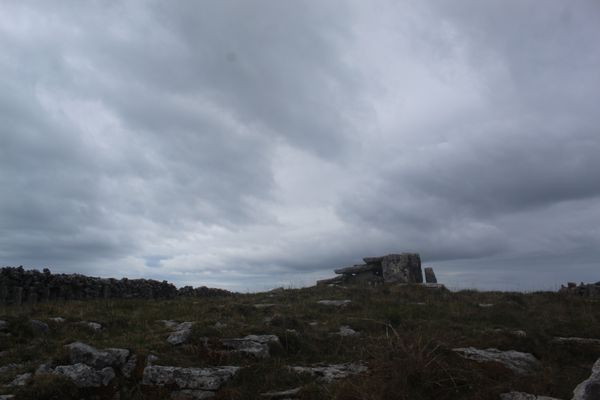Just off the west coast of Ireland lies Inis Mor, the largest island in an archipelago called the Aran Islands. Artists and writers have thrived on these islands for centuries, inspired by their bleak and lonely beauty. All three islands share treeless, wind-blown landscapes populated almost exclusively by cows, donkeys, and hundreds of maze-like stone walls. I was lucky enough to study abroad in Ireland this spring with the IES Dublin Writers Program, and traveling to the Aran Islands was at the top of my bucket list. After navigating several bus and ferry routes, I found myself biking across Inis Mor’s ruin-speckled highlands, unable to hear my thoughts over the silence.
The Aran Islands are home to one of Ireland’s last communities of native Irish speakers, and it is their geographical extremity that enabled them to preserve their language. History has not always been kind to Ireland. Centuries of British colonization, famine, and emigration almost laid waste to the Irish language, a language that would otherwise remain Ireland’s vernacular today. Every child is required by law to study Irish in primary school, but only 4.2 percent of the population speaks Irish fluently.
The numbers are discouraging, but Irish is still very much alive. Storytelling and poetry are vital to modern Irish culture, and poets were historically believed to possess mystical powers. Out on the Aran Islands, where the wind seems to have a language of its own and the people still speak as their ancestors did nine generations ago, it is easy to understand why.
Back on Ireland’s east coast sits Dublin, a city just as linguistically rich as the Aran Islands, but in a different way. At least 17.1 percent of the city is home to immigrants who have moved to Ireland in the past twenty years. A pedestrian exploring the city streets might hear conversations in Polish, Swahili, Portuguese, Chinese, Arabic and dozens of other non-English languages. And while Irish is not heard as often in Dublin as it is on Ireland’s west coast, Dublin is home to 20.2 percent of all Irish speakers.
While you might not hear Irish spoken on the streets of Dublin, you will undoubtedly see it written out on signs, scribbled across walls in graffiti, or stuck to lampposts as stickers. Poems in Irish are plastered to the sides of trashcans. Bus signs and tram stops alternate between Irish and English announcements. Place names are usually doubled—Irish first, then English below.
Learning Irish is not easy. Its spelling system is often incomprehensible to outsiders, and the grammar is only remotely related to English. When Ireland was first invaded by the English in 1169, its language was one of the few cultural protections Irish people had against being Anglicized. But in 1830, Great Britain created the Ordnance Survey of Ireland in an attempt to replace Irish place-names with English ones. Gaillimh became Galway. Béal Feirsde became Belfast. Baile Átha Cliath became Dublin. Irish was effectively outlawed by the British Empire, and the Irish educational, judicial and legislative systems exclusively used English. By the late 19th century, most Irish citizens spoke English as their first language.
Today Irish is making a comeback, aided not just by those dedicated to speaking it but also by award-winning writers such as Doireann Ní Ghríofa and Éilís Ní Dhuibhne. The market for Irish literature is small but strong, and the efforts of Irish-language writers prove how important a language is to their native culture.
Studying literature in Dublin was one of the greatest experiences of my life. Before living in Ireland, I had never been to a place ingrained with such love for writing and language. Irish writers are often overlooked in the American education system, but their legacy is unquestionable. Without James Joyce and Samuel Beckett, W. B. Yeats or Seamus Heaney, our modern concept of English literature would look very different. Irish writers have been influencing English literature for centuries, but the Irish language also deserves to stand in the modern spotlight.
On Inis Mor there is a megalithic tomb from 2,500 B.C., weather-beaten but preserved. It stands on a hill doubling as a cow pasture, surrounded by miles of stone walls that have been rebuilt and repaired for centuries. You can walk right up to it and lie down in it if you want to. There is no sign to mark it, no explanation for what it used to be, no obstructive devices for warding off tourists. It has been left as it is, and it has survived for millennia. The Irish language is a bit like that—it has been battered by centuries of conflict, invasion, and change, but it endures, and it welcomes.
Statistics were sourced from the Central Statistics Office in Ireland.
